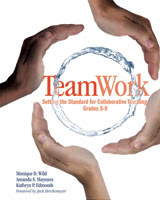 After reading Jeff Anderson's Everyday Editing, I could not wait to read his first book, Mechanically Inclined: Building Grammar, Usage, and Style into Writer's Workshop. Luckily, I already had it on order before I even started Everyday Editing.
After reading Jeff Anderson's Everyday Editing, I could not wait to read his first book, Mechanically Inclined: Building Grammar, Usage, and Style into Writer's Workshop. Luckily, I already had it on order before I even started Everyday Editing.Initially, I thought that there would not be a whole lot new as far as background information. I wanted the book for the additional lesson ideas; however, there actually was a lot of additional information as well. Part One of the book contains four chapters of introductory and background information on Anderson's ideas and how to make them work. Then part two has six sections of topics with 4-6 lessons each, and the appendix has example student support documents that accompany the lessons.
Early in the book Anderson discussed how teachers often talk about their students' lack of ability to edit, revise, and self-correct, but in actuality it is a result of teachers not teaching their students with sufficient exposure. He also provides a list of questions for teachers to ask themselves when students are not as successful with grammar and mechanics as teachers would have hoped (10-11). I can closely relate to this because I noticed certain trends in student errors last year with my 6th graders and I provided some support to improve; however, I knew that I needed to be doing more. I just was not sure how. I did not feel equipped to support my students in making the necessary improvements. That is why I am so excited about Anderson's ideas and already have plans to regularly integrate them throughout the whole year. It will be especially exciting to see the change in student writing for those who according to our state writing rubric meet in every area except conventions, which is double weighted.
Anderson advocates brief (5-10 minutes) daily grammar instruction in order for students to internalize the structures. He emphasizes why it is more beneficial to highlight what is right in sentences, rather than a traditional Daily Oral Language program that does not transfer over into students' everyday writing (15-19).
There were many recurring themes throughout the whole book that I loved. For example, instead of getting frustrated with student errors, Anderson pointed out what to celebrate in the error and then how to move the student forward. They were typically a result of students expanding the complexity of their writing and just not knowing how to properly punctuate their new higher level of thinking. In addition, he provided many scaffolding and supports that reminded me of suggestions for English Language Learners, such as sentence frames. This again makes for a seamless transition into integrating his concepts into our dual immersion context where all students are learning an additional language. Most importantly, he is always explaining the spirit of language play in the classroom, making the lessons come alive in order to engage students. Since I am still fairly new to incorporating writer's notebooks in my classroom, I appreciated his explanation of how he sets his up (30).
I am so excited to see the positive changes Anderson's ideas will bring for my students. I love the format of the book which provides sufficient information and modeling for me to picture how to incorporate these ideas into my class. A lot of the mentor texts he mentioned are already in my classroom library, making it even easier. I also want to share the idea with other teachers at my school.























